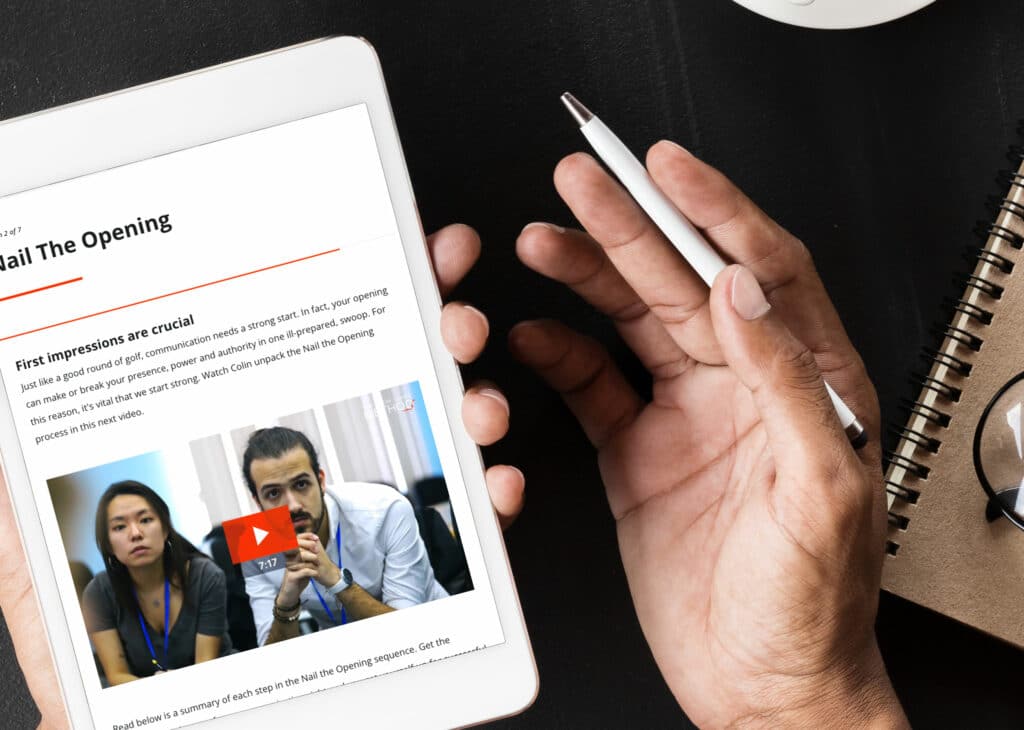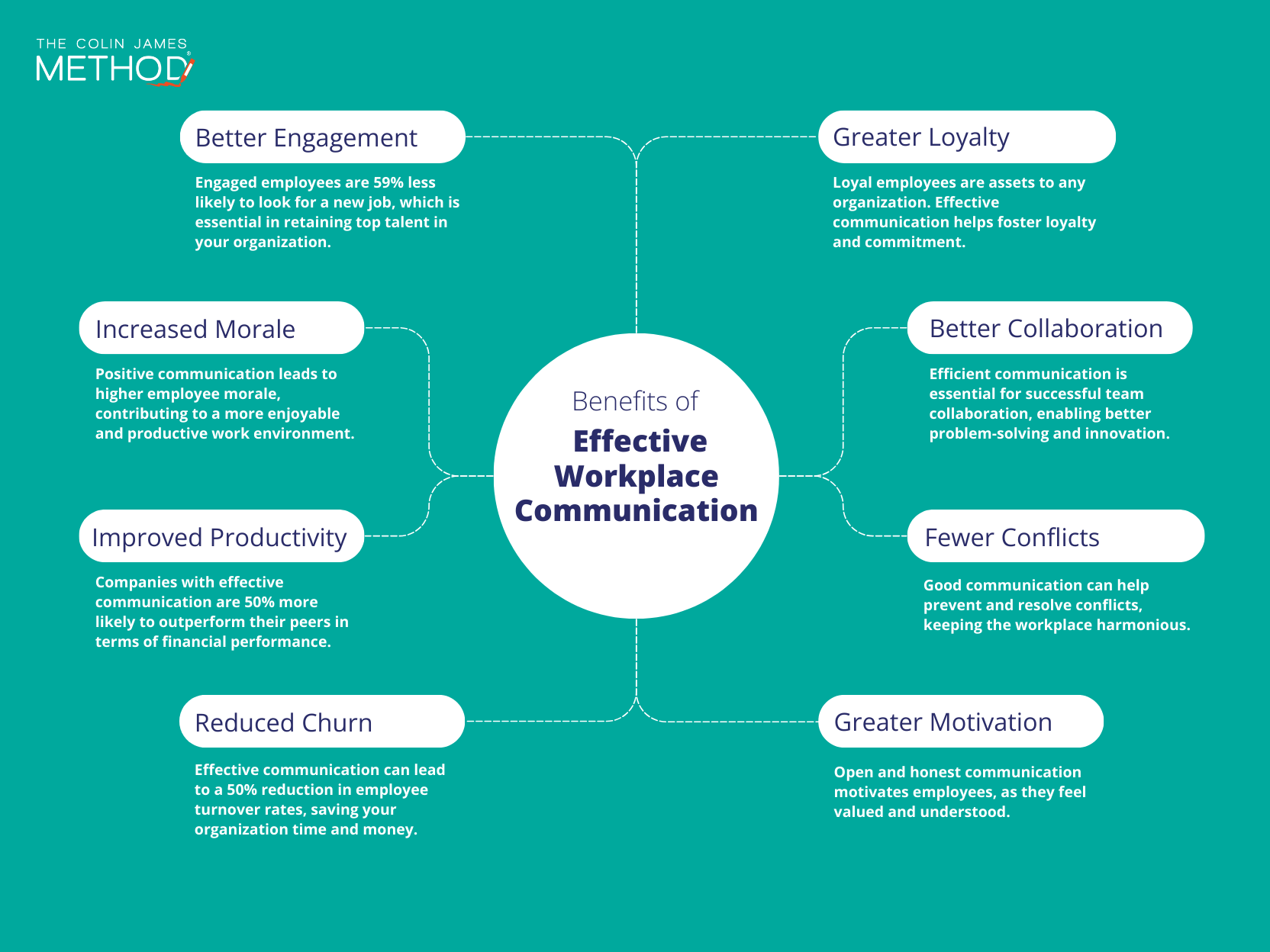Summary
- Workplace Communication encompasses verbal, non-verbal, and written exchanges within an organization, promoting understanding, collaboration, and a shared sense of purpose.
- Benefits of effective workplace communication include better engagement, increased morale, improved productivity, reduced churn, greater loyalty, better collaboration, fewer workplace conflicts, and greater motivation.
- The 7 types of workplace communication include leadership communication, upward communication, updates, presentations, meetings, customer communications, and informal interactions.
- Strategies for improving remote communication include clarifying expectations, engaging in two-way communication, using video conferencing effectively, focusing on the quality of written communication, creating informal spaces, and showing care.
- There are 8 ways you can develop communication skills at work. These include:
- thinking before communicating
- avoiding rushing
- simplifying language
- being direct
- experimenting with communication methods
- practicing and reflecting
- considering non-verbal cues
- seeking feedback
- When communicating with colleagues, you should emphasize using a friendly, relaxed communication style, speaking positively and with discretion, offering constructive criticism, and praising good work.
- When communicating with managers consider using a formal communication style, adapting to the manager’s preferred style, keeping the manager informed, asking for feedback, and seeking help when needed.
- When communicating with customers it is advised to use a friendly, formal style, encouraging customers to lead the conversation, and involving other team members when necessary.
Introduction
Effective communication is essential for any successful workplace. It’s the invisible force that ties a team together, ensuring that they operate cohesively, efficiently, and harmoniously. In today’s fast-paced and evolving work environment, mastering the art of workplace communication has become more critical than ever. Whether you’re a team member, a manager, or a business owner, understanding and implementing effective communication strategies can make a significant difference in your workplace.
In this blog post, we will explore what workplace communication means, its benefits, and provide you with valuable insights on how to improve your communication skills in various aspects of your professional life.
What does “effective workplace communication” mean?
Workplace communication encompasses all the verbal, non-verbal, and written exchanges that occur within an organization. It includes conversations with colleagues, superiors, clients, and partners, as well as written documents, emails, and presentations. Effective workplace communication ensures that everyone is on the same page, promoting understanding, collaboration, and a shared sense of purpose.
Benefits of open & effective workplace communication
✔️ Better Engagement
Engaged employees are 59% less likely to look for a new job, which is essential in retaining top talent in your organization – Wigert, “The Four Essential Dynamics of Hybrid Work.”
✔️ Increased Morale
Positive communication leads to higher employee morale, contributing to a more enjoyable and productive work environment.
✔️ Improved Productivity
According to a study by Towers Watson, companies with effective communication are 50% more likely to outperform their peers in terms of financial performance – Pumble Learn,“Statistics on Workplace Communication in 2023,”
✔️ Reduced Churn
Effective communication can lead to a 50% reduction in employee turnover rates, saving your organization time and money – ExecView, “Communication Breakdown: Why Should You Address Your Workplace Communication.”
✔️ Greater Loyalty
Loyal employees are assets to any organization. Effective communication helps foster loyalty and commitment.
✔️ Better Collaboration
Efficient communication is essential for successful team collaboration, enabling better problem-solving and innovation.
✔️ Fewer Workplace Conflicts
Good communication can help prevent and resolve conflicts, keeping the workplace harmonious.
✔️ Greater Motivation
Open and honest communication motivates employees, as they feel valued and understood.
📗 [Case Study] Asana: How the most effective teams in the world collaborate
According to research by Asana, the most successful teams in the world have a few common traits when it comes to collaboration and workplace communication.
They are encouraging collaboration by using impactful processes and workflows to “unite cross-functional teams, helping them achieve more together than they could independently“. But what does this really look like?
According to Asanas’ research they have condensed the best strategies into four simple steps:
-
Set team-wide goals – Impactful work starts with one to three North Stars. They cover the big goal (or goals) that your entire organization strives towards.
-
Identify project that ladder into each goal – break down objectives into smaller chunks
-
Consolidate your content, communication, and coordination into one place – Without a single source of truth for planning, tracking, and executing work, teams can’t align their efforts
-
Build out cross-functional workflows – workflows grant cross-functional teams a common language
We love these four strategies outlined by Asana because they provide such a clear and practical framework for improving collaboration and workplace communication.
These strategies reflect best practices for enhancing teamwork, communication, and alignment within an organization. They also promote clarity, goal-driven action, transparency, and efficient collaboration, all of which are essential for achieving success in a competitive and rapidly changing business environment. It’s important for organizations to tailor these strategies to their specific needs and continuously iterate on them to adapt to changing circumstances and goals.
Looking for more? Check out the full download here.
We especially loved this one from Asana as well: “Collaboration in the workplace: 11 ways to boost your team’s performance”.
7 common types of communication in the workplace
Effective communication is the backbone of a successful workplace, and it takes various forms to keep the gears of an organization running smoothly. Here are seven common types of communication in the workplace:
1. Leadership communication
This type involves top-down communication, where leaders convey their vision, expectations, and directives to the rest of the organization. It sets the tone and provides a sense of direction for the entire team.
2. Upward communication
In contrast to leadership communication, this is the flow of information from employees to management. It allows employees to share their concerns, suggestions, and feedback, promoting a transparent and responsive work environment.
3. Updates
Regular updates are essential to keep everyone informed about the progress of projects, changes in processes, and important developments within the company. Timely and clear updates ensure that everyone is on the same page.
4. Presentations
Whether in meetings or larger gatherings, presentations are a powerful way to communicate complex ideas, data, or proposals. Effective presentation skills are crucial for conveying information convincingly.
5. Meetings
Meetings serve as a forum for discussions, decision-making, and collaboration. They can take various forms, including brainstorming sessions, project updates, or strategic planning meetings.
6. Customer communications
Maintaining good relations with customers is vital. Communication in this context includes responding to inquiries, resolving issues, providing product information, and delivering excellent customer service.
7. Informal interactions
The watercooler conversations, quick chats in the hallway, or virtual coffee breaks are all part of the informal interactions that foster relationships, camaraderie, and the exchange of ideas among colleagues. These interactions often contribute to a positive workplace culture.
How has COVID-19 changed the landscape of workplace communication?
COVID-19 has dramatically transformed workplace communication, reshaping the way we interact, collaborate, and connect within professional settings. One of the most significant changes is the widespread adoption of remote work. With remote work becoming the new normal, digital communication tools like Zoom, Slack, and Microsoft Teams have taken center stage, replacing in-person meetings and watercooler conversations. Video conferences have become the primary medium for team meetings, presentations, and even job interviews.
Moreover, the pandemic has underscored the importance of clear and empathetic communication from leadership. Employees now seek reassurance and information from their organizations on issues like health and safety protocols, remote work policies, and updates on the evolving situation.
The nature of meetings has also evolved, with a greater emphasis on shorter, more focused discussions to combat “Zoom fatigue.” Virtual team-building activities and informal check-ins have become essential for maintaining team cohesion and morale.
The pandemic has accelerated the use of asynchronous communication, allowing employees to collaborate across different time zones. Platforms like Slack and email have evolved to accommodate this shift, with the option to send messages and updates that can be read and responded to at one’s convenience.
COVID-19 has not only altered the way we communicate but also highlighted the importance of empathy and mental health support in the workplace. The lines between personal and professional life have blurred, making it crucial for employers to show understanding and flexibility. COVID-19 has transformed workplace communication by making it more digital, asynchronous, empathetic, and adaptable to remote work.
📓 Further Reading: How To Develop Remote Work Skills & Future-Proof Your Teams
How to improve communication when working remotely?
If we’ve all gone remote/hybrid since COVID-19, then how do we communication in this virtual world? Improving communication when working remotely is crucial for maintaining productivity and team cohesion. Here are some effective strategies to enhance remote communication:
- Clarify Expectations: Ensure that all team members have a clear understanding of their roles, responsibilities, and project timelines. Use tools like project management software and detailed task lists to keep everyone on the same page.
- Engage in Two-Way Flow: Encourage open and constructive communication. Listen actively and encourage team members to share their thoughts, questions, and concerns. This creates a collaborative environment where ideas can flow freely.
- Remember the Power of In-Person: While remote work is prevalent, video conferencing can simulate the experience of in-person meetings. Use video calls for important discussions and presentations to foster a more personal connection.
- Focus on Quality: Written communication, such as emails and messages, should be clear and concise. Pay attention to grammar and tone to avoid misunderstandings. Edit and proofread important documents and messages.
- Create an Informal Space: Establish channels or times for informal conversations, similar to watercooler chats in the office. Virtual coffee breaks or casual chat rooms can help build rapport among team members.
- Show You Care: Demonstrate empathy and care for your colleagues’ well-being. Inquire about their day, listen to their concerns, and offer support when needed. This builds trust and a sense of camaraderie.
- Take a Course: Consider enrolling in a communication course, especially if you find remote communication challenging. Courses focused on virtual communication, presentation skills, or active listening can provide valuable insights and strategies.
By implementing these strategies, you can foster effective communication within your remote team, ensuring that everyone stays connected, motivated, and informed.
📓 Further Reading
- Slack: Companies are moving work forward with new co-working capabilities in huddles
- Slack: Beyond the smile: how emoji use has evolved in the workplace
Check out these great posts from Slack on communicating remotely in the workplace ☝️
8 ways to develop communication skills at work
Developing strong communication skills at work is essential for professional success. Here are eight effective ways to enhance your communication abilities:
- Think About It: Before communicating, take a moment to organize your thoughts. Consider your message’s purpose, key points, and the most effective way to convey it.
- Don’t Rush: Take the time to craft well-thought-out messages, especially for important matters. This approach helps you avoid misunderstandings and errors.
- Make It Easy: Simplify your language and message structure. Avoid jargon or overly complex terms. Make it easy for your audience to understand your message.
- Direct: Get to the point. Clear and concise communication is often more effective than lengthy explanations. Focus on delivering the essential information.
- Experiment and Diversify: Don’t be afraid to try different communication methods and styles. Experiment with various channels and approaches to find what works best for different situations and audiences.
- Practice and Reflect: Practice your communication skills regularly, both in written and verbal forms. After each communication, reflect on what went well and what could be improved.
- Consider the Big Picture: Effective communication goes beyond words. Pay attention to your non-verbal cues, such as body language and tone of voice. They can significantly impact the message you convey.
- Ask for Feedback: Actively seek feedback from colleagues, supervisors, or mentors. Constructive feedback helps you identify areas for improvement and refine your communication skills continually.
How to communicate effectively with colleagues
Effectively communicating with colleagues is necessary for creating robust working partnerships. These are four significant strategies for accomplishing this:
- Use a Friendly, Relaxed Communication Style: Approach your colleagues with a friendly and relaxed demeanor. A warm, approachable style encourages open and honest dialogue. Avoid being overly formal when it’s not necessary, as it can create unnecessary barriers.
- Speak Positively and with Discretion: Maintain a positive tone in your conversations, even when discussing challenging topics. Avoid negative or gossipy discussions that can breed negativity in the workplace. Exercise discretion in sensitive matters to build trust with your colleagues.
- Offer Constructive Criticism: When you need to provide feedback or address issues, do so in a constructive and respectful manner. Focus on specific behaviors or actions that need improvement and offer suggestions for how to address them. Be sure to frame your criticism in a way that encourages growth and positive change.
- Praise Good Work: Recognize and praise your colleagues for their accomplishments and contributions. Acknowledging their efforts and achievements not only boosts morale but also reinforces a culture of appreciation and support in the workplace.
Incorporating these communication strategies into your interactions with colleagues can foster a more affirmative, direct, and cooperative workspace, resulting in firmer work connections and improved team collaboration.
📓 Further Reading: How To Use Your Workplace Communication Skills To Stand Out
How to communicate effectively with managers
Effective communication with your manager is vital for a successful professional relationship. Here are five strategies to enhance your communication with managers:
- Use a Formal Communication Style: When interacting with your manager, it’s generally best to use a more formal style, especially for important matters. This conveys respect and professionalism. However, adapt your style to your manager’s preferences, as some may prefer a more casual approach.
- Use Their Preferred Communication Style: Pay attention to how your manager communicates and adapt to their preferred style. Some may prefer email, while others favor in-person or phone conversations. Being flexible in this regard can make your communication more efficient.
- Keep Your Manager Informed: Regularly update your manager on your projects, tasks, and any important developments. Transparency and clear communication help your manager stay informed and trust that you’re on top of your responsibilities.
- Ask for Feedback: Proactively seek feedback from your manager. Inquire about your performance, areas for improvement, and your manager’s expectations. Constructive feedback is essential for personal and professional growth.
- Ask for Help: If you encounter challenges or need assistance, don’t hesitate to ask your manager for help or guidance. They are there to support you, and seeking help when needed demonstrates your commitment to success and your willingness to collaborate.
By applying these strategies, you can foster a productive and positive working relationship with your manager, leading to more effective communication and a better understanding of your roles and responsibilities.
How to communicate effectively with customers
Effective communication with customers is essential for building and maintaining positive relationships. Here are three key strategies for communicating effectively with customers:
- Use a Friendly, Formal Communication Style: Striking the right balance between friendly and formal communication is crucial. Customers should feel comfortable and valued, so maintain a polite and professional tone. Be attentive to their needs, addressing them by name when possible, and use courteous language in your interactions.
- Encourage Them to Lead the Conversation: Actively listen to your customers and encourage them to express their needs and concerns. Ask open-ended questions to understand their requirements and preferences. When they feel heard and understood, it enhances the customer experience and fosters trust.
- Involve Other Team Members, When Required: If a customer’s inquiry or issue goes beyond your expertise, involve other team members who can provide more specialized assistance. Ensure a smooth handoff and keep the customer informed of the transition. This approach demonstrates your commitment to resolving their concerns effectively.
By implementing these strategies, you can create a positive and productive rapport with customers, leading to enhanced satisfaction, trust, and loyalty to your business or organization.
📓 Further Reading: Customer Experience: 3 Reasons Why Soft Skills Training Is The Key
Final Thoughts
In the ever-evolving landscape of the workplace, effective communication stands as a beacon of success. As you continue to refine your skills and embrace the power of clear, respectful, and empathetic communication, remember that you are not just improving your own career but also contributing to the overall harmony of your team and the growth of your organization. Embrace the opportunities to connect, to learn, and to inspire one another through meaningful conversations.
The journey to effective workplace communication may have its challenges, but with each step forward, you’re creating a more vibrant and collaborative professional world. So, keep those lines of communication open, and let your voice be the catalyst for a brighter, more harmonious workplace where success knows no bounds.













